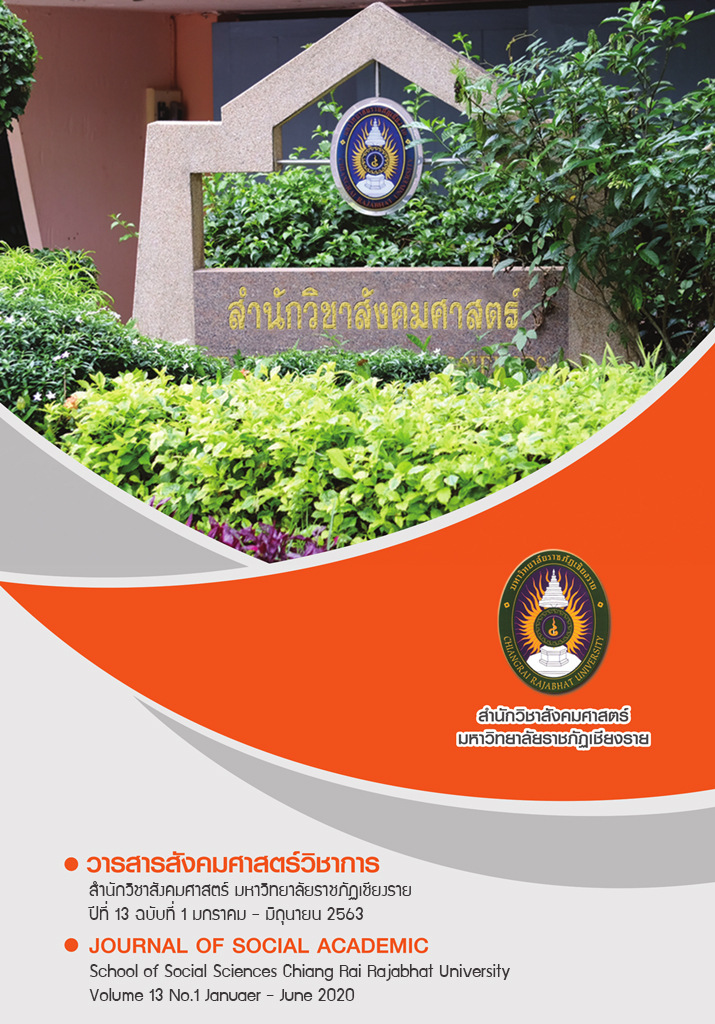The Structural Equation Modeling of Applying Sufficiency Economy Philosophy to Sustain SMEs in the Upper North of Thailand โมเดลสมการเชิงโครงสร้างการประยุกต์ใช้ปรัชญาเศรษฐกิจพอเพียงเพื่อสร้างความยั่งยืนแก่วิสาหกิจขนาดกลางและขนาดย่อมในเขตภาคเหนือตอนบน ประเทศไทย
Main Article Content
บทคัดย่อ
การวิจัยครั้งนี้มีวัตถุประสงค์เพื่อศึกษาการประยุกต์ใช้ปรัชญาเศรษฐกิจพอเพียงเพื่อสร้างความยั่งยืนแก่วิสาหกิจขนาดกลางและขนาดย่อมในเขตภาคเหนือตอนบน ประเทศไทย
การวิจัยนี้ใช้วิธีการวิจัยแบบผสมผสาน (mixed methods research) ซึ่งเป็นการวิจัยแบบคุณภาพและการวิจัยเชิงปริมาณ โดยการวิจัยเชิงคุณภาพ เป็นการวิจัยที่ใช้ในช่วงแรกของการวิจัย โดยเครื่องมือที่ใช้ในการวิจัยคือแบบสัมภาษณ์กึ่งโครงสร้าง ทำการสัมภาษณ์ผู้ประกอบการวิสาหกิจขนาดกลางและขนาดย่อม จำนวน 5 ราย และนำผลจากการสัมภาษณ์ไปสร้างแบบสอบถามเพื่อใช้ในการวิจัยระยะที่สอง ซึ่งเป็นการวิจัยเชิงปริมาณ โดยมีกลุ่มตัวอย่างจำนวน 518 กิจการ และใช้โปรแกรม AMOS ในการวิเคราะห์สมการเชิงโครงสร้าง
ผลการวิจัยพบว่า จากสมการเชิงโครงสร้างของการประยุกต์ใช้ปรัชญาเศรษฐกิจพอเพียงเพื่อสร้างความยั่งยืนให้แก่วิสาหกิจขนาดกลางและขนาดย่อมในเขตภาคเหนือตอนบน ประเทศไทยนั้น ปรัชญาเศรษฐกิจพอเพียง และกลยุทธ์ธุรกิจ ต่างส่งผลต่อความยั่งยืนของวิสาหกิจขนาดกลางและขนาดย่อม แต่กลยุทธ์ธุรกิจจะส่งผลต่อความยั่งยืนของวิสาหกิจขนาดกลางและขนาดย่อมมากกว่าการประยุกต์ใช้ปรัชญาเศรษฐกิจพอเพียงแต่เพียงอย่างเดียว ซึ่งหมายความว่าการจะทำให้วิสาหกิจขนาดกลางและขนาดย่อมยั่งยืนได้นั้น ต้องมีการนำปรัชญาเศรษฐกิจพอเพียงมาเป็นส่วนหนึ่งในการกำหนดกลยุทธ์ธุรกิจเพื่อให้เกิดความยั่งยืนในอนาคต
Article Details
รายละเอียดของลิขสิทธ์
เอกสารอ้างอิง
Carlson, M., & Mulaik, S. A. (1993). Trait ratings from descriptions of behavior as mediated by components of meaning. Multivariate Behavioral Research, 28(1), 111-159.
Comrey, A. L., & Lee, H. B. (1992). A First Course in Factor Analysis (2nd ed.). Lawrence Earlbaum Associates. Publishers: Hillsdale, New Jersey.
Grant, R. M. (1996). Toward a knowledge‐based theory of the firm. Strategic management journal, 17(S2), 109-122.
Hoelter, JW. (1983). 'The analysis of covariance structures: Goodness-of-fit indices', Sociological Methods & Research, 11 (3), pp. 325-44.
Hu, L. T., & Bentler, P. M. (1998). Fit indices in covariance structure modeling: Sensitivity to underparameterized model misspecification. Psychological methods, 3(4), 424.
Jeffcoate, J., Chappell, C., & Feindt, S. (2002). Best practice in SME adoption of e-commerce. Benchmarking: An international journal, 9(2), 122-132.
National Economic and Social Development Board (NESDB). (2004). What is Sufficiency Economy?. Bangkok, Thailand : NESDB.
Nidumolu, S. R., Subramani, M., & Aldrich, A. (2001). Situated learning and the situated knowledge web: Exploring the ground beneath knowledge management. Journal of management information systems, 18(1), 115-150.
Office of Small and Medium Enterprises Promotion (OSMEP). (2017). “SMES situation”. From http://203.154.140.77/sme/Report/View/1188. Retrieved 25th July 2018.
Office of Small and Medium Enterprises Promotion (OSMEP). (2018). SME master plan 2017-2021. From http://www.sme.go.th/upload/mod_download/แผนแม่บทฯ%20ฉบับที่%204.pdf. Retrieved 24th December 2018.
Oxford business Group. (2016). Thailand applied sufficiency economy philosophy to promote sustainable development. From https://oxfordbusinessgroup.com/overview/middle-way-applying-king’s-philosophy-sufficiency-economy-long-term-sustainable-development. Retrieved 15th November 2018.
Pruetipibultham, O. (2010). The sufficiency economy philosophy and strategic HRD: A sustainable development for Thailand. Human Resource Development International, 13(1), 99-110.
Puntasen, A., Premchuen, S., & Keitdejpunya, P. (2003). Application of the royal thought about the Sufficiency Economy in SMEs. Bangkok: Thailand Research Fund.
Sasin (Sasin Graduate Institute of Business Administration of Chulalongkorn University). (2010). Corporate Sustainability under the Sufficiency Economy Philosophy. .From http://social.nesdb.go.th. Retrieved on 15 November 2018.
Taylor, M. P. (1999). Survival of the fittest? An analysis of self‐employment duration in Britain. The Economic Journal, 109(454), 140-155.
Thongpoon, S. (2012). Sustainable Performance of Thai SMEs: Investigating the Entrepreneurial Competencies and Sufficiency Economy Philosophy. Asia Pacific Journal of Management & Entrepreneurship Research, 1(2), 5.
Ullman, JB. (2001). “Structural equation modelling”, in BG Tabachnick & LS Fidell (eds), Using multivariate statistics (4th ed.). Allyn & Bacon, pp. 635-771.
U-tantada, S., Mujtaba, Bahaudin G. & Yolles, M. and Shoosanuk, A. (2016). Sufficiency economy and sustainability, proceedings of the 2nd multidisciplinary research and innovation for globally sustainable development (MRIGSD), extra issue, p 84-94.
United Nations. (2016). The Ten Principles of the UN Global Compact. From www.unglobalcompact.org. Retrieved 25th July 2016.
Wiboonchutikula, P. (2002). “Small and medium enterprises in Thailand: Recent trends”. Small Business Economics, vol, no.1, pp.211-224.
Yu, C. (2002). 'Evaluating Cutoff Criteria of Model Fit Indices for Latent Variable Models with Binary and Continuous Outcomes', Doctor of Philosophy in Education, thesis, University of California.


